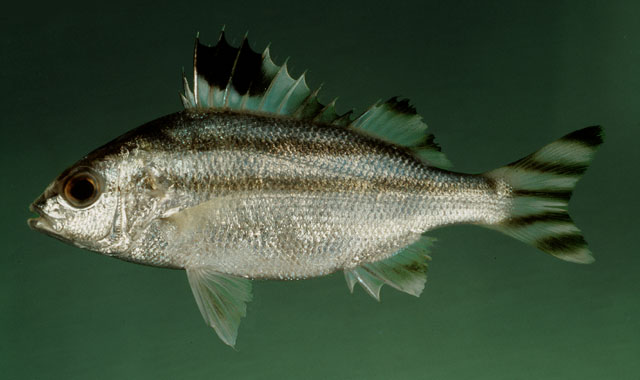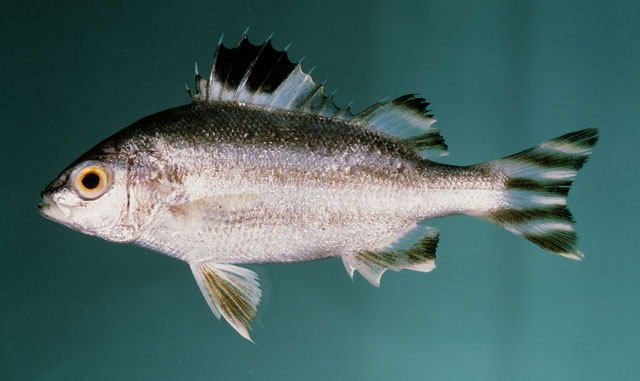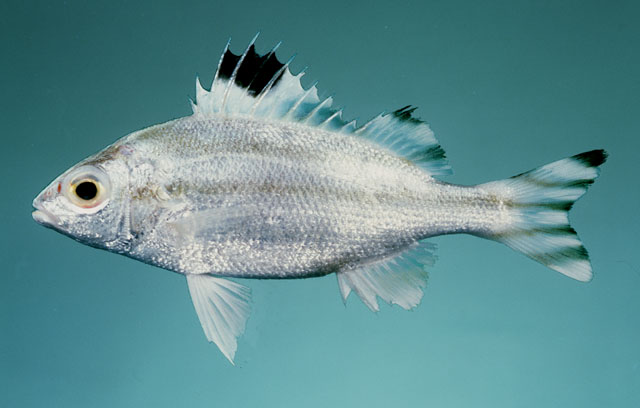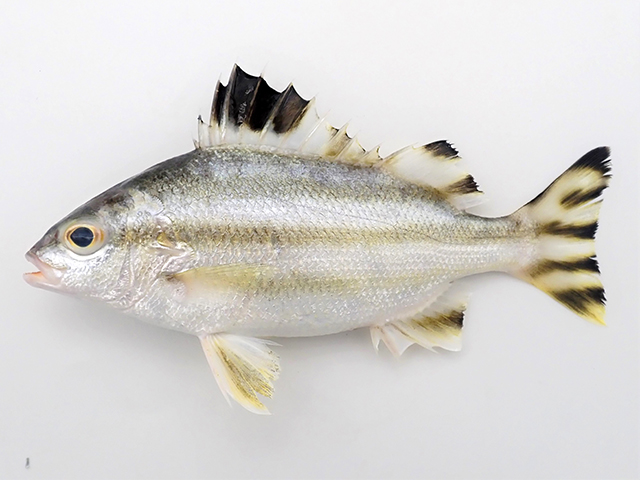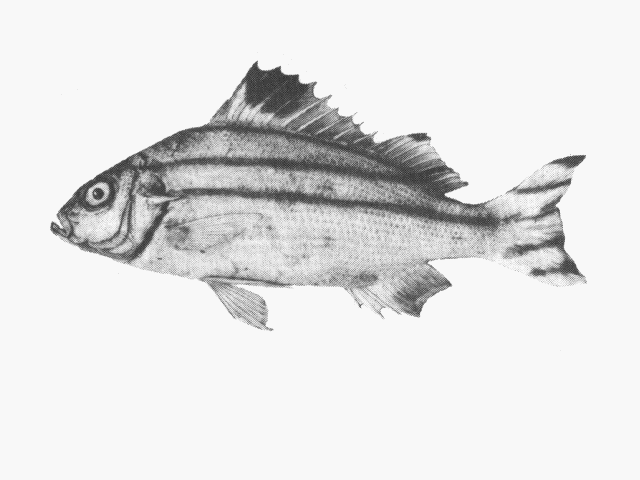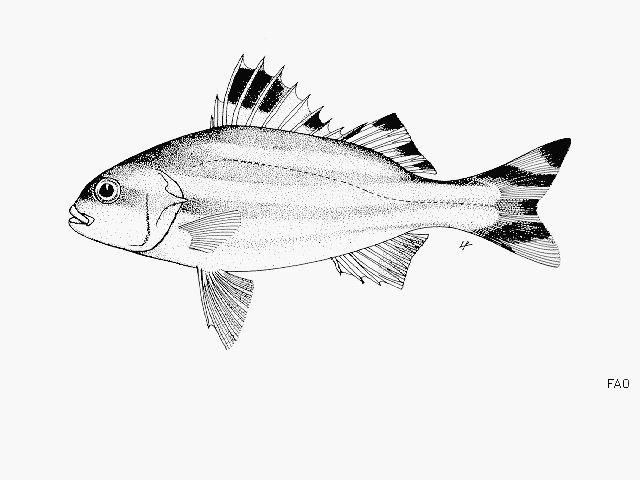Terapon
theraps
Cuvier,
1829
Largescaled terapon
View all media / Upload your photos and videos
Expand all
Classification / Names
Teleostei (teleosts) > Centrarchiformes (Basses) >
Terapontidae (Grunters or tigerperches)
More on author:
Cuvier.
Environment / milieu / depth range / climate zone / distribution range
Marine; brackish; freshwater; reef-associated; depth range ? - 10 m (Ref. 86942); tropical; 36°N - 35°S20°E - 168°E.
Distribution
Maps

Terapon theraps / Native range
AquaMaps Data sources:
GBIF
OBIS
This map was computer-generated and has not yet been reviewed.

Terapon theraps / Suitable habitat
AquaMaps Data sources:
GBIF
OBIS
This map was computer-generated and has not yet been reviewed.

Terapon theraps / Point map
AquaMaps Data sources:
GBIF
OBIS
This map was computer-generated and has not yet been reviewed.

Terapon theraps / Year 2050
AquaMaps Data sources:
GBIF
OBIS
This map was computer-generated and has not yet been reviewed.
Size / Weight / Age
Max length: 30.0 cm SL male/unsexed (Ref. 4327).
Short description
Dorsal spines (total): 11 - 12; Dorsal soft rays (total): 9 - 11; Anal spines: 3; Anal soft rays: 7 - 9. Body oval, compressed, robust. Lower opercular spine extending well beyond the opercular flap. Post-temporal bone exposed posteriorly and serrate. Color is dusky green above, white below; body, head and fins with an iridescent sheen. Four longitudinal brown stripes extend on the upper side from the head. A large prominent black blotch is on the distal end of the spinous portion of the dorsal fin. Similar brown stripes run across the caudal fin. (from Ref. 3131). Description: Characterized by the following: horizontal scale rows above lateral line scales 6-8; head length 2.8-3.5 in SL; greatest depth of body 2.4-3.5 in SL (Ref. 90102).
Biology
Life cycle and mating behavior
Eggs are guarded and fanned by the male parent (Ref. 205).
Main reference
Paxton, J.R., D.F. Hoese, G.R. Allen and J.E. Hanley 1989 Pisces. Petromyzontidae to Carangidae. Zoological Catalogue of Australia, Vol. 7. Australian Government Publishing Service, Canberra, 665 p. (Ref. 7300)
IUCN Red List Status (Ref. 125652)
Least Concern (LC); date assessed: February 15 2011
CITES (Ref. 131153)
Not Evaluated
CMS (Ref. 116361)
Not Evaluated
Threat to humans
Harmless
More information
- Countries
- FAO areas
- Ecosystems
- Occurrences
- Introductions
- Stocks
- Ecology
- Diet
- Food items
- Food consumption
- Ration
- Common names
- Synonyms
- Metabolism
- Predators
- Ecotoxicology
- Reproduction
- Maturity
- Spawning
- Spawning aggregation
- Fecundity
- Eggs
- Egg development
- Age/Size
- Growth
- Length-weight
- Length-length
- Length-frequencies
- Morphometrics
- Morphology
- Larvae
- Larval dynamics
- Recruitment
- Abundance
- References
- Aquaculture
- Aquaculture profile
- Strains
- Genetics
- Allele frequencies
- Heritability
- Diseases
- Processing
- Mass conversion
- Vision
- Pictures
- Stamps, Coins Misc.
- Sounds
- Ciguatera
- Speed
- Swim. type
- Gill area
- Otoliths
- Brains
Estimates based on models
Preferred temperature (Ref. 123201): 24.9 - 29.3, mean 28.5 °C (based on 3179 cells).
Phylogenetic diversity index (Ref. 82804): PD50 = 0.625 [Uniqueness, from 0.5 = low to 2.0 = high].
Bayesian length-weight: a=0.01122 (0.00680 - 0.01852), b=3.04 (2.90 - 3.18), in cm total length, based on LWR estimates for this species & (Sub)family-body (Ref. 93245).
Trophic level (Ref. 69278): 3.7 ±0.5 se; Based on food items.
Generation time: 1.8 ( na - na) years. Estimated as median ln(3)/K based on 2 growth studies.
Resilience (Ref. 120179): High, minimum population doubling time less than 15 months (K=0.6-0.8).
Fishing vulnerability (Ref. 59153): Low vulnerability (24 of 100).
Price category (Ref. 80766): Unknown.
Nutrients (Ref. 124155): Calcium = 67 [41, 112] mg/100g; Iron = 0.668 [0.427, 1.005] mg/100g; Protein = 19.6 [18.6, 20.5] %; Omega3 = 0.14 [0.09, 0.21] g/100g; Selenium = 22 [13, 39] μg/100g; VitaminA = 71 [25, 205] μg/100g; Zinc = 1.54 [1.12, 2.09] mg/100g (wet weight);


